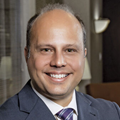Q&A Update with Keith Bricking, MD
 By Keith Bricking, MD, system chief clinical officer, Premier Health
By Keith Bricking, MD, system chief clinical officer, Premier Health
We recently interviewed Dr. Bricking, Premier Health’s first chief clinical officer, about the direction he sees Premier Health taking to fulfill its new vision to inspire better health.
Before stepping into his new current role, Dr. Bricking served as president of Atrium Medical Center and was the first physician to lead a Premier Health hospital.
What excites you the most about your new role as chief clinical officer, and what new initiatives will you be heading up that will most directly affect our physicians and APPs?
One of the things that excites me the most about my new role as Chief Clinical Officer is working with teams from all over the system. In my first four to five months, I have learned a lot about the different entities I was not exposed to in previous experiences. We've got an incredible workforce at all levels, and working with teams at hospitals, physician practices, and other system entities has been quite gratifying.
The new initiative I've been focused on is the next evolution of our service lines. Recently I rolled out a new structure around what those core service line teams will look like.
It will be critical to have physicians and advanced practitioners throughout the organization involved in the service lines. Over the last, six to eight months, [we have had] -physician led teams working together on supply costs and collaborating on our supply chain opportunities.
Premier Health recently released its 2035 strategic plan with four strategic pillars: academic and research distinction; workforce development; operational excellence; and partnerships. What role can our clinical teams across the health system expect to play in fulfilling our strategic plan in the short term and long term?
There are going to be opportunities for clinicians to engage in all four of the pillars of our strategic plan. We are currently in the process of standing up teams to drive operational excellence throughout Premier. This includes optimization of workflows and efficiencies in our medical imaging department, surgery departments, cardiology cath labs, and other outpatient services throughout the continuum of care. It also includes purposeful growth and collaboration in all markets. From an academic pillar [standpoint], our system already differentiates itself by providing an exceptional experience for learners in our facilities and offices. We want to build upon that foundation and enhance our academic distinction in the market by further differentiating ourselves through teaching, research, and academic programming.
Premier Health faces several challenges, as do other health care providers across the industry. What’s a challenge that’s front and center for you in your new position, and how can our medical workforce make a difference in addressing it?
We are no different from others across the country. Our biggest challenges are workforce shortages and the cost of labor. There is an opportunity for our workforce to embrace technology and alternative care models to support our caregivers to function at the top of their license.
We also need to look at our resource utilization. It will be critical to make sure that patients are getting the right care at the right place at the right time. We should challenge ourselves to leverage evidence based clinical pathways to reduce testing and ordering where appropriate.
Can you provide an update on how clinical and operational leaders are collaborating to ensure top-decile patient care and experience?
I've witnessed firsthand a much more integrated approach between the physician company, hospitals, and service lines working together on system initiatives. Barb Johnson, our system chief operating officer and president of Miami Valley Hospital, and I have stood up a weekly meeting with leaders from all entities throughout the system to specifically work on how we can execute our operational goals and priorities for the system. When we bring people together to collaborate, we see better teamwork and quicker patient-centered results.
What leadership opportunities are emerging for our physicians and APPs? How can they lean in and influence initiatives across Premier Health?
There are opportunities throughout the system, whether it's an advanced practitioner or a physician, to engage in all kinds of initiatives. We have medical staff committees and operational work groups [that providers and advanced practitioners can join].
As we stand up the teams around the four pillars of the strategic plan, providers will have many opportunities to engage in our academic programming, our research programs, and the operational working teams that we discussed earlier. The new design for the service lines will also call for additional physician-led committees [through which] our providers can truly contribute to the success of the service lines. We are being intentional to include providers from all over the system on our medical staff committees. I would encourage providers to reach out to their site chief medical officer or myself directly via email if they would like to get involved.
We know change can be hard to adapt to. What do you want to leave with our clinical teams across the system to encourage them on this journey?
Our 13,000 employees across Premier have been through a lot over the last couple of years. It’s important that we take the time to recognize and appreciate the fantastic work that has occurred. As we look toward the future, we must continue to adapt to and embrace the rapid pace of change. I am excited about the future and confident that we have all the talent needed to take on our current challenges while providing exceptional care for the communities we serve. I would encourage our providers to get involved and work with the collective healthcare team to inspire better health.
I look forward to working beside them on this journey.
Back to the March 2023 issue of Premier Pulse

